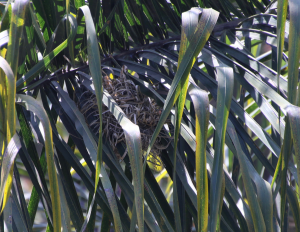Weaver species list / RELATED SPECIES: Baglafecht Weaver / Bannerman’s Weaver / Bertram’s Weaver / Giant Weaver / Orange Weaver / Principe Golden Weaver / Vieillot’s Black Weaver / Weyns’s Weaver
IUCN: Least concern Discovery: 023
Categories: acacias, fruit, gum, nectar, palm, Ploceus 3
Discovery
  IntroductionThe Baglafecht Weaver was formally described by Francois Marie Daudin, a young French zoologist. For this species Daudin simply provided a scientific name for a bird described by Buffon.The earliest reference to the Baglafecht Weaver is by Buffon in 1775, where he called it Le Baglafecht. Buffon provided a brief description of the species and noted that it came from Abyssinia (Ethiopia). The Baglafecht Weaver was most probably noted by James Bruce, a Scottish traveller in North Africa and Ethiopia. Bruce travelled in Africa from 1768 to 1773, and later wrote some travel books. Bruce, and his assistant Luigi Balugani, painted over 300 plants, birds, and animals, but did not write much about the new fauna and flora he found. Murray, who wrote a biography on Bruce (1808), mentioned a painting of a bird called the yellow Bagla finch. Bruce met Buffon in France in 1773, and the painting by Bruce must have been the source for Buffon’s description of the Baglafecht Weaver. Bruce was based mostly at Gondar, which is probably where he observed the Baglafecht Weaver. Bruce’s painting of the Baglafecht Weaver probably exists in a gallery, but it does not appear to have been published anywhere. The first published illustration of the Baglafecht Weaver appeared many decades after the bird was first described. Ferret and Galinier 1848 published several hand-coloured plates in their book on Ethiopia, including one of the Baglafecht Weaver. Scientific citationLoxia baglafecht Daudin 1802 In Buffon, Hist. Nat., ed. Lace’pe`de, Quad., 14, p.245 Abyssinia, ex idid., Oiseau Rev. Franc. Orn., 6, p.191. Meaning of namesbaglafecht Probably from a native Abyssinian (Amharic) name. Bruce refers to Bagla as a language or tribe. Buffon first used the name “baglafecht”, and this must be based on his meeting with Bruce. First English nameyellow Bagla finch (Bruce 1791) Alternate namesElgon Weaver, Emin’s Weaver, Frick’s Weaver, Golden-Crowned Weaver Bird, Lado Baglafecht Weaver, Neumann’s Bagafecht Weaver, Reichenow’s Weaver, Stuhlmann’s Weaver, Uhehe Stuhlmann’s Weaver. CollectorJames Bruce. Date collected1768-73, when Bruce was in Ethiopia. Locality collectedEthiopia, probably in Gondar. Type specimensType specimen not traced. |
The above is based on Weaver Wednesday 2, a weekly series about the discovery of each weaver species.
This species text first appeared as Weaver Wednesday [140] – Discovery [23]: Baglafecht Weaver on 2015-02-17
1. Basic biology
The above is based on Weaver Wednesday, a weekly series about weaver species.
This species text first appeared as Weaver Wednesday [99]: Baglafecht Weaver on 2014-05-07
2. Breeding facts
| Pair bond Monogamous Breeding season Nest site Nest building Colony size Clutch size Egg colour Egg size Incubation Chicks and nestling period |
Breeding information based on Handbook of the Birds of the World, Vol. 15.
3. Photos of Weaver Nests
 Vm 29088 |
 Vm 28051 |
 Vm 28047 |
 Vm 27915 |
 Vm 27759 |
 Vm 27673 |
Thumb-nails of most recent PHOWN records


